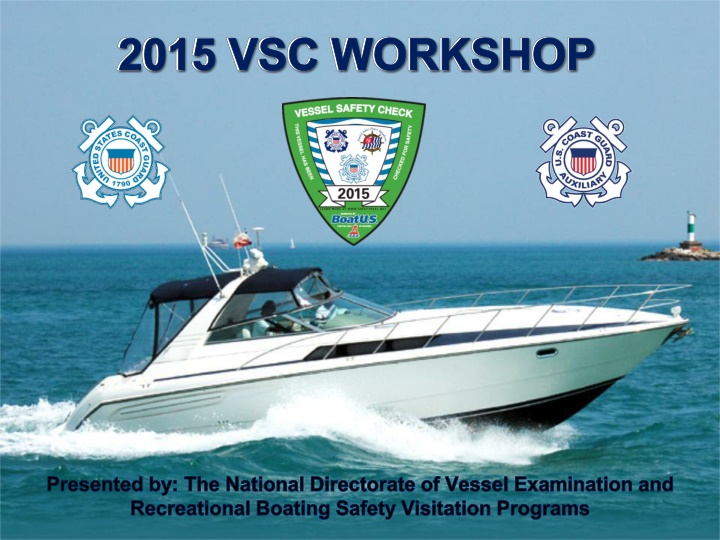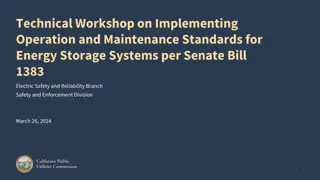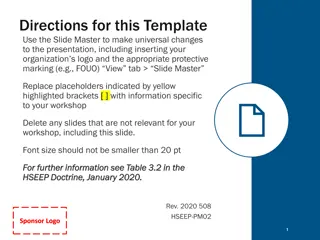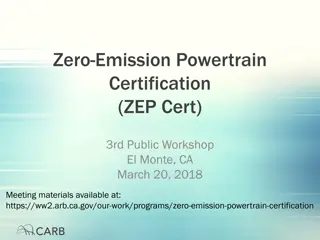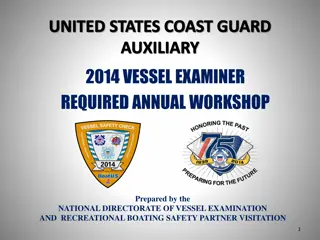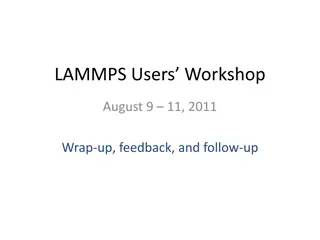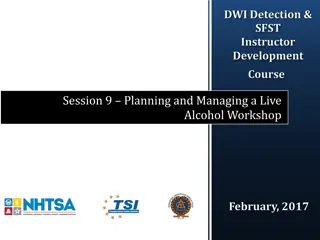2015 VSC WORKSHOP
The 2015 VSC Workshop presented by The National Directorate of Vessel Examination and Recreational Boating Safety Visitations Programs focused on providing vessel examiners with current rules and regulations to educate recreational boaters. The workshop reviewed the new Vessel Safety Check Manual and highlighted key changes. Additionally, the National RBS Program's mission is to enhance boating safety, minimize risks, and ensure compliance with boating laws. The workshop also emphasized the importance of the Vessel Safety Check Program in promoting safety awareness among boaters.
Uploaded on Feb 16, 2025 | 1 Views
Download Presentation

Please find below an Image/Link to download the presentation.
The content on the website is provided AS IS for your information and personal use only. It may not be sold, licensed, or shared on other websites without obtaining consent from the author.If you encounter any issues during the download, it is possible that the publisher has removed the file from their server.
You are allowed to download the files provided on this website for personal or commercial use, subject to the condition that they are used lawfully. All files are the property of their respective owners.
The content on the website is provided AS IS for your information and personal use only. It may not be sold, licensed, or shared on other websites without obtaining consent from the author.
E N D
Presentation Transcript
2015 VSC WORKSHOP Presented by: The National Directorate of Vessel Examination and Recreational Boating Safety Visitation Programs
Workshop Objectives To provide our Vessel Examiners with the most current, up-to-date rules, regulations, and laws available to assist them in educating the recreational boater during vessel safety checks This year we have tailored the workshop to review the recent changes/additions outlined in the NEW Vessel Safety Check Manual (COMDTINST M16796.8A) There are several subtle, and important changes in the manual that will be discussed
National RBS Program Mission Statement To minimize loss of life, personal injury, property damage, and the environmental impact associated with the use of recreational boats through preventative means to maximize the safe use and enjoyment of United States waterways by the public. RBS is Job #1
The Vessel Safety Check Program continues to be the primary method to help boaters achieve voluntary compliance with federal and state recreational boating laws. THE VSC IS A TWO PRONGED APPROACH TO BOATING SAFETY 1. ENSURES CARRIAGE OF THE REQUIRED SAFETY EQUIPMENT. 2. RAISES THE BOATER S AWARENESS THROUGH ONE-ON-ONE CONTACT. What a better time than during a vessel safety check to introduce the boater to the Coast Guard Auxiliary s classroom and E-Courses Public Education Programs.
Reviewing the New VSC Manual FORMAT TERMINOLOGY REVIEWING THE MANUAL NEW CHAPTERS UNIFORMS WEARING LIFE JACKETS CERTIFICATION / RECERTIFICATION BELL REQUIREMENTS REQUIREMENTS FOR BATTERY TERMINALS MARPOL TRASH PLACARD OIL POLLUTION PLACARD LATEST UPDATES NAVRULES, BACKFIRE FLAME ARRESTOR SUPPLEMENT
Terminology Wording throughout the manual is written to make careful use of the words: SHALL MAY SHOULD MUST
Shall Where the word shall appears in the text, it means that vessel examiners are specifically required to take a particular action. By the same token, the phrase shall not means they are prohibited from taking that action. For example: At the end of each vessel safety check, vessel examiners shallgive the operator of the vessel a copy of the completed Vessel Safety Check, Form ANSC 7012. That means the vessel examiner is required to do so, according to the procedures for conducting a vessel safety check that have been promulgated by the U.S. Coast Guard.
May The word maymeans that the practice or action described is only a suggestion or an option for the vessel examiner or the boater, and not a requirement for obtaining a decal.
Should When the word shouldis used, it means that the procedure or option that follows it is strongly recommended by the U.S. Coast Guard as a preferred boating safety practice, but is not required for the vessel to qualify for a vessel safety check decal. Vessel examiners are prohibited from denying a vessel safety check decal as long as the vessel meets the requirements specified in the list of VSC decal requirements. The vessel does not have to have the recommended and discussion items listed on the Vessel Safety Check Form ANSC 7012/7012a.
Must The word must is used to signify that a vessel has to carry a specific piece of equipment, or that the equipment has to be labeled or used in a specific way in order to meet U.S. Coast Guard standards and to qualify for a vessel safety check decal. Example: To qualify, a life jacket must be in good and serviceable condition and contain a label showing that it has been approved by the U.S. Coast Guard.
Reviewing the Manual The next time you review the manual, remember to keep the four words we just discussed in mind. SHALL MAY SHOULD MUST They will help you gain a better understanding in the intent of the vessel safety check and hopefully do away with previous gray areas.
New Chapters in the Manual Chapter 5: Paddle Craft Chapter 6: Operational Facilities Rather than needing to refer to a separate manual or addendum, everything is located in one clear and concise location. This will make it easier for new members training to be a Vessel Examiner.
Chapter 5 Paddle Craft This chapter outlines specific paddle craft VSC requirements and provides valuable information for the Vessel Examiner not familiar with paddle craft. It also provides insight and tips into additional recommended equipment and topics to discuss with paddlers, allowing for a more educational one-on-one interaction.
Chapter 6 Operational Facilities This chapter is designed to aid the Vessel Examiner in understanding the related paperwork and requirements necessary to offer a vessel as an Operational Facility. All Operational Facilities must first meet the standards for a vessel safety check, and then are required to meet the Operational Facility requirements as outlined on ANSC form 7003 (ANSC form 7008 for PWC s) Note: The District Commander (through the DIRAUX) may specify additional requirements and equipment to support Auxiliary operations. Always check with your specific district for details.
Uniforms Changes in policy: Whether they are members of the Auxiliary or the Power Squadrons, vessel examiners shall wear the appropriate uniform or authorized clothing when conducting scheduled vessel safety checks or participating in a Vessel Safety Check Day event. The Uniform of the Day for Auxiliarists performing vessel safety checks is the Operational Dress Uniform (ODU). The optional Vessel Examiner polo shirt or the hot weather uniform prescribed in the Auxiliary Manual, COMDTINST M16790.1 (series) may be worn while conducting Vessel Safety Checks. (Districts vary regarding wearing the Hot Weather Uniform)
Wearing Life Jackets Policy Change: Auxiliarists shall wear a life jacket while conducting vessel safety checks on vessels that are in the water and are encouraged to do so during classroom training to promote their use among the boating public.
Certification & Recertification of Vessel Examiners There are no changes. The new manual simply adds clarification. Let s take a minute to review the process.
Initial VE Qualification Shall Hold BQ Status in AUXDATA Auxiliarists in AP status may qualify after meeting requirements as outlined in the Auxiliary Manual (COMDTINST M 16790.1 ref: 3.D.2.f) Shall take and pass the open book VE Qualification Examination Three (3) hour time limit Passing score of 90% Shall conduct five (5) VSC s under the supervision of a certified VE Examinations using ANSC Form 7012A are NOT authorized During the qualification process the certified VE is credited with the VSC s performed
Annual Certification Complete a minimum of five (5) Vessel Safety Checks using ANSC forms 7012/7012a. This also includes OPFAC inspections Completion of a mandatory workshop, if so designated by NEXCOM Vessel Examiners would be notified well in advance Minimum of VSC s Annually
Recertification If any qualified vessel examiner fails to perform the annual certification procedures within the last year, they must complete two satisfactory vessel safety checks, as a trainee, under the supervision of a certified vessel examiner utilizing the Vessel Safety Check, Form ANSC 7012. Paddle craft examinations using ANSC 7012 A are not authorized. Performing OPFAC inspections are also counted toward the required examinations. Only the certified vessel examiner receives the credit for the two recertification vessel safety checks. The Auxiliarist must then complete the annual certification procedures to retain certification for the following year. 2 THEN5 VSC s after Recertified to meet Annual Requirement Supervised VSC s to get Recertified
Loss of Qualification If a vessel examiner fails to perform the annual certification procedures for five (5) consecutive years, that member must complete the full initial certification process to regain qualification.
Bell Requirements Again nothing new. Simply brings the VSC manual up to date with current Navigational Rules (NAVRULES). Vessels examined under the current vessel safety check requirements are not required to carry a bell. Note: The Navigational Rules: International Inland, will NO longer be available from the government in a hard copy version. They will only be available in an electronic version.
Batteries Batteries should be secured and terminals covered to prevent accidental arcing. Covering just the positive terminal is acceptable to prevent accidental arcing Some states may require that both the positive and negative terminals be covered to prevent accidental arcing IMPORTANT ADDITION/CLARIFICATION Vessels with outboard motors are exempt from this requirement
New Marpol Trash Placard The new manual helps to clarify the MARPOL Plaque requirement United States vessels 26 feet or longer must display in a prominent location a durable placard notifying the crew and passengers of the discharge restrictions The specific Marpol Placard size and language is not specified. However, the new Marpol Placard is shown above and available from ANSC. Order ANSC #4067 - STICKER, "GARBAGE DUMPING RESTRICTIONS" (5 "x 8 ") OFFSHORE. Similar placards are also available for purchase from retail outlets. Regardless a vessel that is required to display a Marpol Placard Must have a Marpol Placard displayed (new or old)
Pollution Placard Vessel Examiners that conduct VSC s on vessels that require an new Oil Pollution Placard can order them from ANSC. Similar placards are also available for purchase from retail outlets. Order info: ANSC#4064 - STICKER, DISCHARGE OF OIL PROHIBITED FWPCA (5" x 8") - Information on discharge of oil or oily waste into or upon the navigablewaters of the United States.
NAVRULES ALCOAST 411-2014 CLARIFICATION ON CARRIAGE OF ELECTRONIC NAVIGATION RULES Vessel operators are reminded that 33 CFR 83.01(g) requires: The operator of each self- propelled vessel 39.4 FEET (12 meters) or more in length shall carry on board, and maintain for ready reference, a copy of these Rules. The Navigation Rules book ..allows the electronic format of specific navigation publications.
NAVRULES contd The impediment to allowing an electronic copy of the Navigation Rules is the requirement for access and "ready reference". The rule of thumb for "ready reference" means that vessel operators must be able to open up the book in two minutes or less. Such access is challenging for many electronic devices, especially if they are on a computer or laptop. FOR FURTHER CLARIFICATION PLEASE REFER TO: NATIONAL V-DIRECTORATE WEBSITE FOR POSTING OF ALCOAST 380/14 PROMUGLATION OF THE NAVIGATIONAL RULES AND REGULATIONS HANDBOOK
Supplement to New Manual Found on V-Directorate Website Gas engines installed in a motor boat or motor vessel after April 25, 1940, except outboard motors, must be equipped with an acceptable backfire flame control. The backfire flame arrester must be suitable secured to the intake with a flame tight connection and is required to be either USCG approved or comply with SAE J-1928 or UL 111 standards and marked accordingly. Refer to the actual manual supplement regarding other acceptable flame controls including air induction systems, velocity stacks and reed type backfire flame arresters
New VSC Manual COMDTINST M16796.8A The new VSC Manual, COMDTINST M16796.8A is only being released in electronic format by the Coast Guard. Some Vessel Examiners may wish to have the manual available as a Hard Copy reference. The CG Auxiliary Association has made arrangements to have our manuals printed at discount rates. To take advantage of this offer PLEASE SEE THE DIRECTOR-V s MEMO ON THE WHAT S NEW PAGE, LOCATED ON THE V-DIRECTORATE S NATIONAL WEB SITE Or go directly to: http://wow.uscgaux.info/content.php?unit=V- DEPT&category=dir-v-says
Its Important Youre Important Some take always Let s make the most of our one-on-one time while talking with boaters. BE SURE TO STRESS THE IMPORTANCE OF TAKING AN AUXILIARY CLASSROOM OR AUXILIARY E-COURSE BOATER SAFETY CLASS. The information YOU pass along may well prevent an accident or save a life. YOU ARE AN AMBASSADOR REPRESENTING THE U.S. COAST GUARD AND U.S. COAST GUARD AUXILIARY. SEMPER PARATUS
2015 V-DIRECTORATE STAFF Prevention Through Prevention Through Interaction Interaction Director-V: Deputy Director-V: Division Chief-Vessel Examination: Division Chief-Visitation Programs: Division Chief-Communications: Division Chief- Incentives: Division Chief-Technical Services: Michael S. Klacik Andrew J. Render Joseph C. Reichal Jr. William J. Howard Norman L. Fehr Jr. John Yskamp
